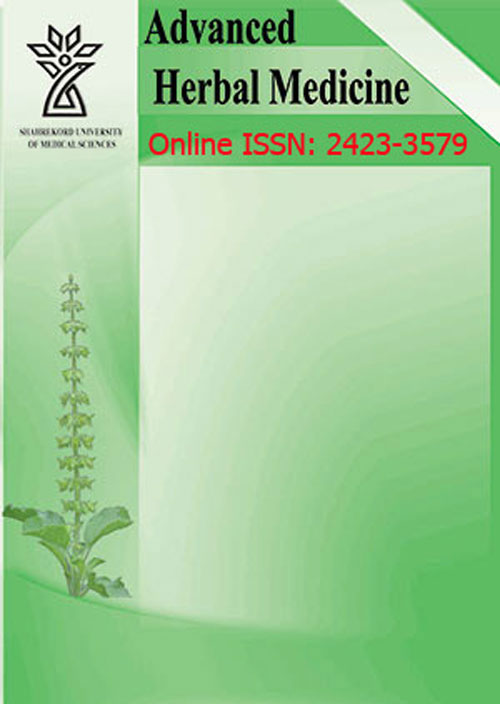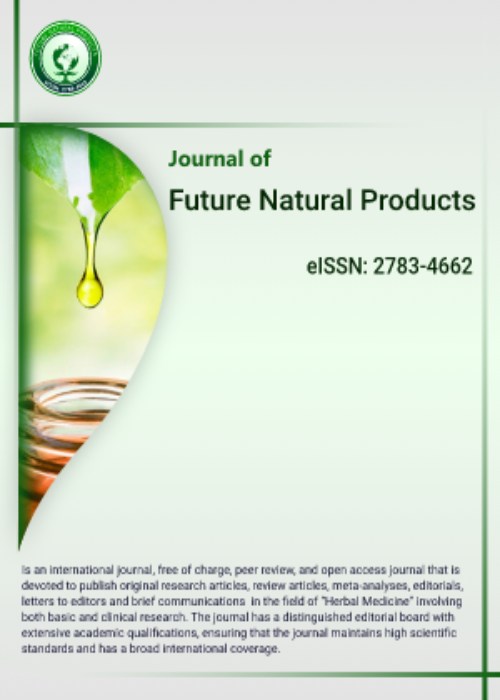فهرست مطالب

Future Natural Products
Volume:7 Issue: 1, Winter-Spring 2021
- تاریخ انتشار: 1400/09/07
- تعداد عناوین: 5
-
Pages 1-13Background and aims
Medicinal mushrooms are known for their potential for the treatment of various diseases such as cancer and gastrointestinal disorders. Fomes fomentarius is a fungus belonging to the Polyporaceae family with anti-inflammatory, antioxidant, antidiabetic, and antitumor effects.
MethodsThis study aimed to investigate the hepatoprotective effect of F. fomentarius extract in a rat model of carbon tetrachloride (CCl4)-induced toxicity along with its scavenging activity against 2,2-diphenyl-1-picrylhydrazyl.
ResultsBetter antioxidant activity was obtained for ethanol extract of the fungus (IC50: 206.20 µg/mL) compared with its aqueous extract (IC50: 414.33 µg/mL). Levels of alanine aminotransferase, aspartate aminotransferase, lactate dehydrogenase, and alkaline phosphatase decreased after administration of the ethanol extract especially at 100 mg/kg compared with higher doses (200 and 400 mg/kg).
ConclusionTreatment with the lower dose of the extract reduced alkaline phosphatase more pronouncedly than silymarin, indicating the beneficial properties of the fungus for biliary tract diseases. Histopathological findings also showed that F. fomentarius extract at the lower dose could protect against CCl4-induced liver injury, and the mechanism may be related to its antioxidant activity.
Keywords: Alkaline phosphatase, Alanine aminotransferase, Antioxidant, Aspartate aminotransferase, Fungus, Liver enzymes -
Pages 14-23Background and aims
In recent years, due to side effects of chemical drugs, some people hsve turned to traditional medicine. Safflower is a medicinal plant that is used as a relatively cheap dye for making sweets and cooking in addition to its therapeutic effects. Superoxide dismutase (SOD) is one of the important enzymatic antioxidants that plays a role in fighting reactive oxygen species .In this study, the effects of safflower flower on serum activity of SOD in male wistar rats were studied to determine the adverse and beneficial effects of the plant on this important enzymatic antioxidant.
MethodsSixty rats were divided into four groups consisting of three experimental groups and one controle group. The extract of safflower at concentrations of 100, 200 and 300 mg/kg body weight was subcutaneously injected to rats of experimental groups 1, 2 and 3, respectively, for two periods of 14 and 28 days, and then blood samples were collected from their hearts and serum SOD level was measured spectrophotometrically.
ResultsSOD level increased after adminstration of safflower extract at low and medium doses in the short term and at hight doses in the long term.
ConclusionThe safflower extract has beneficial effects on SOD, with no adverse effects on this enzyme at different doses.
Keywords: Safflower flower extract, Superoxid dismutase, Rat -
Pages 24-47
The most recent pandemic of coronavirus disease 2019 (COVID-19) caused by severe acute respiratory syndrome coronavirus 2 (SARS-CoV-2) has challenged the health systems around the world. Currently, there is no definite treatment for COVID-19 and researchers are exploring herbal plant species. Withania Somnifera (WS) and its active ingredients may have potential benefits against COVID-19 activity and related cytokine storm. COVID-19 manifestations are not limited to the respiratory system and extend to vital body organs, a syndrome called multiple organ failure. WS also showed protective effects in different organs such as the lung, heart, liver, and kidneys. In this review, we aimed to summarize the pharmacological effects and underlying mechanisms of WS against COVID-19 and related complications. WS showed anti-inflammatory, antioxidant, hepatoprotective, cardioprotective, antifibrotic, anticancer, and immunomodulatory effects, mainly by downregulating NF-κB and related pathways. The suggested clinical benefits of WS for COVID-19 were investigated by clarifying their underlying mechanisms in this review.
Keywords: Coronavirus, Ashwagandha, Withania somnifera, Herbal Medicine, pharmacology -
Pages 48-65Background and aims
Contrast-induced nephropathy (CIN) is one of the most common reasons for acute kidney failure. Because of the increasing use of contrasts for computed tomography and angiography and coronary interventions, the incidence of CIN is on rise. CIN is a serious and common side effect ofthe use of contrasts. Despite taking of preventative measures, around 30-70% of patients are at risk of CIN. Researchers thus are seeking out appropriate approaches to prevent CIN. Positive effects of many medicinal plants, with antioxidant and anti-inflammatory properties and high efficiency and safety, in decreasing serum creatinine levels have been demonstrated. This study was conducted to collect evidence on the medicinal plants that are effective in decreasing serum creatinine levels and CINdevelopment
MethodsFor this purpose, the key words contrast media, herbal, acute kidney injury, and nephropathy were used to retrieve relevant articles indexed in Google Scholar, Magiran, Elsevier, and PubMed. Then, the eligible articles were included in the review.
ResultsThe results of studies are reported in Table.
ConclusionAlthough some studies have suggested that some herbs have a toxic effect on kidney function, in the present review, most plants could help decrease serum creatinine levels and improve renal function.
Keywords: Contrast media, Nephropathy, herbal, Contrast-Induced Nephropathy -
Pages 66-67
Patients with cancer consistently suffer from a decreased immune response that leads to opportunistic infections and increased morbidity and mortality in these patients. Boosting the immune system in these patients is accomplished by appropriate diet, psychological support and certain drugs such as granulocyte colony-stimulating factor in a clinical setting. Echinacea purpurea also can be used to boost the immune system in cancer patients. Theoretically, E. purpurea can boost the immune system through several mechanisms, including (1, 2) Activating phagocytosis and stimulating granulocytes; Increasing the production of cytokines, especially interleukin 1 and interleukin 6; and Increasing the leukocyte activity. The leachate of E. purpurea aerial parts dramatically increases the percentage of phagocytic action of human granulocytes and increases the phagocytosis of yeast particles under laboratory conditions (in vitro) (1). Interruption of hyaluronidase activity, stimulation of cortex parts of adrenal glands, stimulation of the production of properdin (a serum protein that can neutralize the actions of bacteria and viruses) have also been reported after treatment with this plant (1,2). The pharmacological activity of E. purpurea is related to its compounds and volatile essential oils. The immune system-boosting effect of this plant is related to lipophilic amides, alkamides and caffeic acid derivatives, which is produced by stimulating the phagocytosis of multinucleated granulocytes (2,4). In several studies, E. purpurea effect on preventing or treating infections (3, 4) and on reducing the side effects of anti-cancer drugs was investigated. It was concluded that the products containing E. purpurea exhibit a definite and pronounced effect on stimulating the immune system. As a pediatric oncologist, I used to prescribe E. purpurea for my patients with different types of cancers (hematopoietic and solid malignancies) in recent years and I observed a decrease in opportunistic infections and better immune response in them. Regarding the improved immune system, this plant can probably inhibit the proliferation of malignant cells and tumor recurrence by stimulating NK cells (2) in these patients. This tentative argument should be investigated in future studies. If it is proven, we can use this plant as an adjuvant agent in chemotherapy protocols.
Keywords: Echinacea purpurea, cancer, infection, immune system


